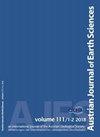奥地利维也纳盆地Gänserndorf UeT3井Glinzendorf向斜白垩系生物地层学与岩石地层学
IF 1.1
4区 地球科学
Q2 Earth and Planetary Sciences
引用次数: 0
摘要
摘要根据3210 m至5140 m的岩屑,对Gänsendorf UeT3井2200 m厚的白垩纪单元进行了生物地层学分析。Tirolic Glinzendorf向斜(被掩埋的北钙质阿尔卑斯山脉的一部分)的沉积物在很大程度上与Grünbach向斜的Lower Gosau亚群有关。基底单元是一个例外,它在Grünbach向斜中没有等效单元。该下部单元细分为非海洋下部和大部分海洋上部。下部没有可用的年龄限制,而上部可能的年龄范围从中土仑阶到科尼亚阶。对于首次从格林岑多夫向斜记录的该单元,我们建议将格林岑道夫组作为新的岩石地层术语。Glinzendorf组被Grünbach组覆盖,Grü。这些被解释为Dreistetten砾岩Mb的等价物。这些单元的钙质超微化石表明其时代为最晚的桑托阶至早期的坎潘阶。Grünbach组沉积期间,非海洋条件占主导地位,但Dreistetten砾岩Mb部分地区存在海洋入侵。Grünbach组的顶部由一个约50米厚的煤单元形成,富含Characeae卵原岩,该煤单元与Dreistetten砾岩一起作为标志层,与Grönbach向斜中的露头进行对比。Grünbach组被Piesting组的泥灰岩和粉质页岩覆盖,记录了其晚坎潘阶和马斯特里赫特阶的时代。在此期间,海洋条件占主导地位。Gänsendorf UeT3井的最上层单元逆掩在马斯特里赫特阶Piesting组上,代表Grünbach组的Campanian砂岩和砾岩。首次探测到该Gänsendorf逆冲断层,并对其进行了生物地层学限制。本文章由计算机程序翻译,如有差异,请以英文原文为准。
Cretaceous biostratigraphy and lithostratigraphy of the Glinzendorf Syncline based on well Gänserndorf UeT3 (Vienna Basin, Austria)
Abstract The 2200 m thick Cretaceous units of well Gänserndorf UeT3 have been biostratigraphically analyzed based on cuttings from 3210 m to 5140 m. The deposits from the Tirolic Glinzendorf Syncline (a part of the buried Northern Calcareous Alps) can be largely correlated with the Lower Gosau Subgroup of the Grünbach Syncline. An exception is the basal unit, which has no equivalent in the Grünbach Syncline. This lower unit is subdivided into a non-marine lower and a largely marine upper part. No age constraints are available for the lower part, whereas the upper part has a possible age range from middle Turonian to Coniacian. For this unit, which is documented for the first time from the Glinzendorf Syncline, we propose Glinzendorf Formation as new lithostratigraphic term. The Glinzendorf Fm. is overlain by the Grünbach Fm., which is intercalated by a thick unit of conglomerates. These are interpreted as equivalents of the Dreistetten Conglomerate Mb. The calcareous nannofossils of these units suggest a latest Santonian to early Campanian age. Non-marine conditions prevailed during deposition of the Grünbach Fm., but marine incursions are indicated for parts of the Dreistetten Conglomerate Mb. The top of the Grünbach Fm. is formed by an about 50-m-thick unit of coal, rich in Characeae oogonia, which, together with the Dreistetten conglomerates serve as marker layer for correlation with the outcrops in the Grünbach Syncline. The Grünbach Fm. is overlain by marls and silty shales of the Piesting Fm. for which a late Campanian and Maastrichtian age is documented. Marine conditions predominated during this interval. The topmost unit in well Gänserndorf UeT3 is overthrusted on the Maastrichtian Piesting Fm. and represents Campanian sandstones and conglomerates of the Grünbach Fm. This Gänserndorf Thrust is detected and biostratigraphically constrained for the first time.
求助全文
通过发布文献求助,成功后即可免费获取论文全文。
去求助
来源期刊

Austrian Journal of Earth Sciences
Earth and Planetary Sciences-Paleontology
CiteScore
3.10
自引率
0.00%
发文量
0
审稿时长
>12 weeks
期刊介绍:
AUSTRIAN JOURNAL OF EARTH SCIENCES is the official journal of the Austrian Geological, Mineralogical and Palaeontological Societies, hosted by a country that is famous for its spectacular mountains that are the birthplace for many geological and mineralogical concepts in modern Earth science.
AUSTRIAN JOURNAL OF EARTH SCIENCE focuses on all aspects relevant to the geosciences of the Alps, Bohemian Massif and surrounding areas. Contributions on other regions are welcome if they embed their findings into a conceptual framework that relates the contribution to Alpine-type orogens and Alpine regions in general, and are thus relevant to an international audience. Contributions are subject to peer review and editorial control according to SCI guidelines to ensure that the required standard of scientific excellence is maintained.
 求助内容:
求助内容: 应助结果提醒方式:
应助结果提醒方式:


